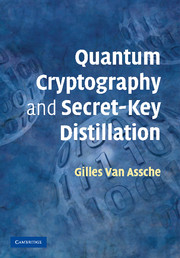Book contents
- Frontmatter
- Contents
- Foreword
- Preface
- Acknowledgments
- 1 Introduction
- 2 Classical cryptography
- 3 Information theory
- 4 Quantum information theory
- 5 Cryptosystems based on quantum key distribution
- 6 General results on secret-key distillation
- 7 Privacy amplification using hash functions
- 8 Reconciliation
- 9 Non-binary reconciliation
- 10 The BB84 protocol
- 11 Protocols with continuous variables
- 12 Security analysis of quantum key distribution
- Appendix symbols and abbreviations
- Bibliography
- Index
9 - Non-binary reconciliation
Published online by Cambridge University Press: 04 August 2010
- Frontmatter
- Contents
- Foreword
- Preface
- Acknowledgments
- 1 Introduction
- 2 Classical cryptography
- 3 Information theory
- 4 Quantum information theory
- 5 Cryptosystems based on quantum key distribution
- 6 General results on secret-key distillation
- 7 Privacy amplification using hash functions
- 8 Reconciliation
- 9 Non-binary reconciliation
- 10 The BB84 protocol
- 11 Protocols with continuous variables
- 12 Security analysis of quantum key distribution
- Appendix symbols and abbreviations
- Bibliography
- Index
Summary
Some QKD protocols, as I will detail in Chapter 11, produce Gaussian key elements. The reconciliation methods of the previous chapter are, as such, not adapted to this case. In this chapter, we build upon the previous techniques to treat the case of continuous-variable key elements or, more generally, the case of non-binary key elements.
In the first two sections, I describe two techniques to process non-binary key elements, namely sliced error correction and multistage soft decoding. Then, I conclude the chapter by giving more specific details on the reconciliation of Gaussian key elements.
Sliced error correction
Sliced error correction (SEC) is a generic reconciliation protocol that corrects strings of non-binary elements using binary reconciliation protocols as primitives [173]. The purpose of sliced error correction is to start from a list of correlated values and to give, with high probability, equal binary strings to Claude and Dominique. The underlying idea is to convert Claude's and Dominique's values into strings of bits, to apply a binary correction protocol (BCP) on each of them and to take advantage of all available information to minimize the number of exchanged reconciliation messages. It enables Claude and Dominique to reconcile a wide variety of correlated variables X and Y while relying on BCPs that are optimized to correct errors modeled by a binary symmetric channel (BSC).
An important application of sliced error correction is to correct correlated Gaussian random variables, namely X ∼ N(0, Σ) and Y = X + ∈ with ∈ ∼ N(0, σ). This important particular case is needed for QKD protocols that use a Gaussian modulation of Gaussian states, as described in Chapter 11.
- Type
- Chapter
- Information
- Quantum Cryptography and Secret-Key Distillation , pp. 141 - 158Publisher: Cambridge University PressPrint publication year: 2006



